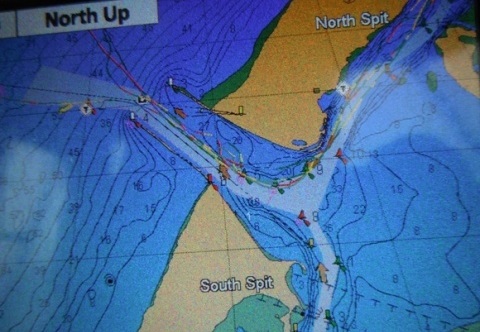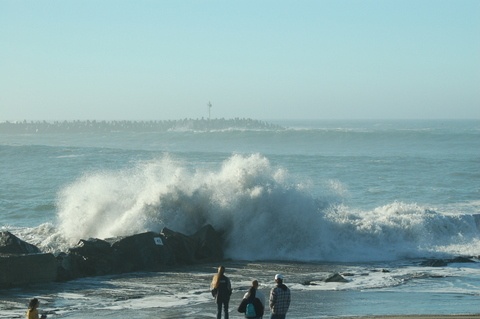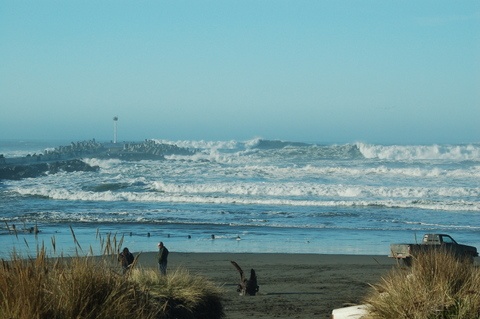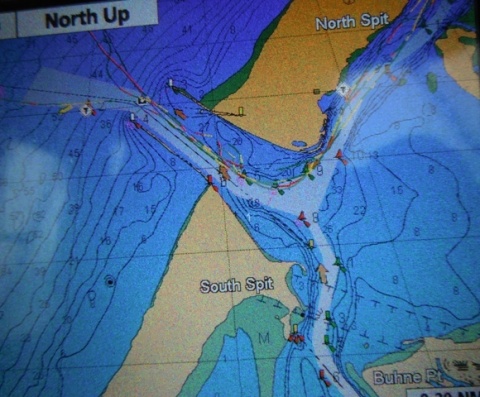
Crossing the Bar at Humboldt Bay

by Tom Marking
3-1-2017
The Humboldt Bay Bar is the stuff of legends. There are harrowing tales of mariners having to cross the Bar at night or during storm conditions, leading to loss of life, with many a ship foundering and capsizing in the mouth and sinking out of sight or being crushed to splinters on the jetties. The Humboldt Bay Bar is considered the second most dangerous Bar on the Pacific Coast second only to the Columbia River Bar. The Coast Guard Station, at the mouth of Humboldt Bay, have many documented incidents and some amazing pictures of fishing vessels crossing the Bar in monstrous waves leaving the boats completely airborne. And yet, the Bar can be a placid and calm with gentle currents and flat glassy water, while six hours later can be a cauldron that none but the foolhardy would dare to try to cross. How is that possible and what’s the rest of the story?
Eureka is a favorite fishing port, with many small boaters traveling from the Central Valley or the Bay Area to our area. Frequent questions by visitors are: What are some of the things they should be aware of while trying to navigate the Humboldt Bay Bar? They are wise to ask, and wiser still to heed the advice they are given by local and seasoned mariners.
1. Check the tide tables. Ebb tide with a 5’+ change of tide can be an issue depending on the height of the next tide and offshore conditions.
2. The swell conditions magnify the outgoing tide. Swell 5’ or more can compress against the outgoing tide and double or triple in size with a very short period. This can lead to breakers at 3-4 second intervals that can be 10-12’ in height on only a 6’ change in tide.
3. Stay in the channel and favor the south side. The channel area north of the green buoys can be as shallow as 13’ due to shoaling of sand. (Remember: Red Right Return for buoys)
4. Getting out is one issue, getting back in is another. Be certain that when you go out, the wind and weather will allow you to get back in on the slack or flood tide. Our winds often pick up at mid-morning and can be at 20 knots by noon, so be certain you don’t have to fight an outgoing tide to get back across the Bar if conditions outside worsen.
5. Fog conditions can happen at any time or day here. Have a good GPS, compass (and Radar if possible), and limit your speed in the fog (use your horn as appropriate).
6. Watch out for smaller craft as you run down the channel and head out of the Jaws We have many smaller boats fishing the jetties and kayakers paddling around and out in the channel.
7. Know the rules for overtaking and passing other vessels or incoming traffic, know buoy markers and light patterns for when a boat is at anchor or moving.
8. In any but the calmest of days, stay on the south side of the channel when clearing the jetties and go slightly southwest or west for several hundred yards before deciding to head north. The area west of the North Jetty has a shoal area of only 30’ and can get very rough and sloppy on even marginal days. In storm events this area can have monstrous waves and breakers that have capsized vessels that attempted to cut the corner on the way back into the mouth.
9. Don’t be underpowered. Currents can run up to 7 knots in the channel and with incoming swell at 20 knots with compressed swell, underpowered boats can find themselves surfing on a swell, and that is very dangerous.
Important Note: due to the current El Nino condition and heavy southern storms over the past two years, the shoaling on the area south of the channel and outside of the jetties is as shallow as 13' and that makes for very a dangerous bar crossing, in all but the calmest waters and on flood tide. Until the channel is dredged out by the Corp of Engineers this summer, all crossing should be very carefully planned and only in very calm weather.
If you find yourself wondering is it safe to get out there, don’t push it. Wait for the tide to slack and go out on the change of the tide so you have six hours to fish and get in on the flood tide. If the offshore waves conditions are over 5’ and square out, you are in for a rough day. (The square = 6’ at 6 seconds, 8’ at 8 seconds, etc) Anything over 3-5’ wind chop will really make for a sloppy day and will test your resolve. Remember, if you go out on a high tide prior to the ebb, you may be out there for six hours before the Bar can be safe to cross to get back in. The one event that capsizes small boats the most is when they are hit with a large following sea and breakers come over your stern. With compressed swell, that can happen very quickly in the JAWS. Also, do not surf your boat in. If the wave builds and you take the drop down the front of the wave, you risk your bow knifing into the water and digging in causing you to quickly veer one way or another. You can flip in the process, or the next wave will catch you broadside and roll you over. Most small boat hulls are flat in the stern with a sharp bow angle. Your back end can swap around very fast if you try to surf in. That can pitch people out of the boat. And remember, always have lifejackets on board and wear them. Things happen very quickly on the water, and you will not have time to search for safety items.
All that being said, thousands of boats traverse through the JAWS without any incidents annually, by watching the tides and water conditions and not taking unnecessary risks. The BAR is not dangerous, but boaters making foolish decisions can create a dangerous situation. Talk to local boaters and build your level of experience. We are out there for recreation, and we should not be putting our lives or the lives of our family or others at risk.
(I’ve added a few pictures: one of the channel from my Furuno Chart Plotter, and a few others of the channel area in heavy runoff and large long period swell building. Some of these waves can be over thirty feet and not even large ships make an attempt to traverse in these conditions.)
Tight lines and be safe out there.
Tom Marking is a Board Member of the Humboldt Area Saltwater Anglers with a membership of about 500 local anglers. In addition, he is also a member of GAP the Groundfish Advisory Subpanel, serving as the CA Sportfishing Representative.
Photos
Website Hosting and Design provided by TECK.net


